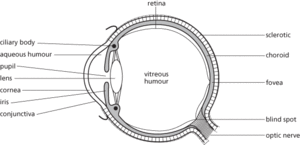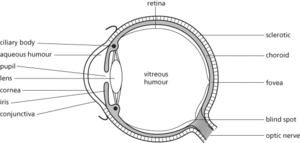The organ of sight. They normally occur in pairs, are nearly spherical, and filled with fluid. Light is refracted by the cornea through the pupil in the iris and onto the lens, which focuses images onto the retina. These images are received by light-sensitive cells in the retina (see cone; rod), which transmit impulses to the brain via the optic nerve.

Eye. Structure of the vertebrate eye.
The organ of sight. The most primitive eyes are the eyespots of some unicellular organisms. More advanced eyes are the ocelli and compound eyes of arthropods (e.g. insects). The cephalopod molluscs (e.g. the octopus and squid) and vertebrates possess the most highly developed eyes (see illustration). These normally occur in pairs, are nearly spherical, and filled with fluid. Light is refracted by the cornea through the pupil in the iris and onto the lens, which focuses images onto the retina. These images are received by light-sensitive cells in the retina (see cone; rod), which transmit impulses to the brain via the optic nerve.

Structure of the vertebrate eye
https://www.emedicinehealth.com/anatomy_of_the_eye/article_em.htm Gross anatomy of the eye, from emedicine
The calm area at the centre of a tropical cyclone.
- hydrogeologic map
- hydrogeology
- hydrograph
- hydrography
- hydroid
- hydroids
- hydroiodic acid
- hydroisomerization
- hydro-isostasy
- hydrolase
- hydrological connectivity
- hydrological cycle
- hydrological pathways
- hydrologic cycle
- hydrologic modelling
- hydrologic network
- hydrologic regions
- hydrologic simulation
- hydrology
- Hydrology and Water Resources Programme
- hydrolysate
- hydrolysis
- hydromagnesite
- hydrometallurgy
- hydrometeor